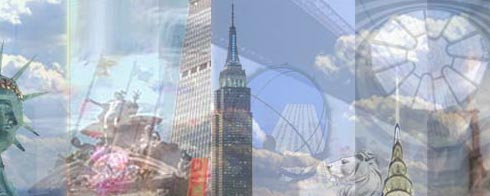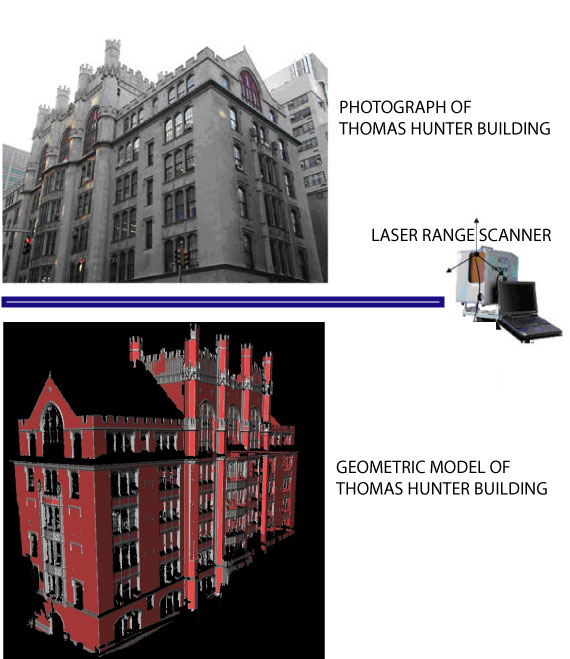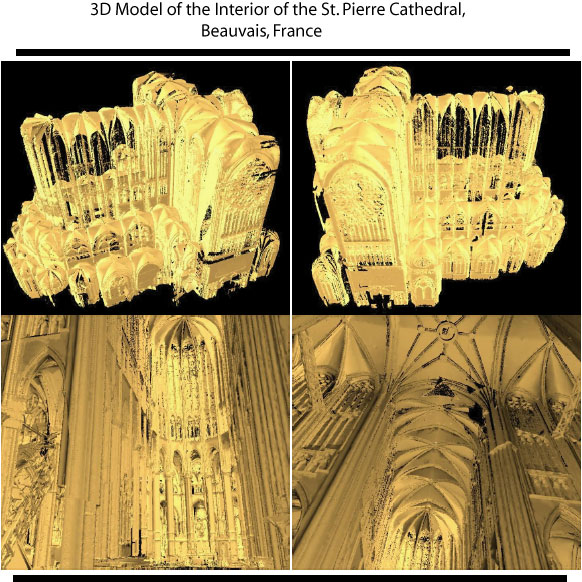
Fall 2003 - CSc
83020 3D Photography
Graduate
Center of The City University of New York
Hunter
College
Day
and Time: Tuesday 4:15 - 6:15
Classroom:
4421 (Thesis Room)
Instructor:
Professor Ioannis Stamos
Email:
istamos@hunter.cuny.edu
WWW: http://www.cs.hunter.cuny.edu/~ioannis
OVERVIEW
Recent advances in
computer hardware have made possible the efficient rendering of realistic
3D models in inexpensive PCs, something that was possible with
high end
visualization workstations only a few years ago. But how can we
automatically produce realistic 3D models of our surroundings. How can
we recover models of static structures (such as buildings), of moving
humans, or even of such tiny structures as proteins? Which input
sensors shall we use (3D laser scanners or digital color cameras),
which techniques are appropriate (stereo vision, image based rendering
or direct 3D modeling), which algorithmic frameworks can be used? Those
answers depend on the applications that utilize the
constructed models: physical simulation, reverse engineering, or
graphics rendering only.
This class will cover the field of 3D Photography -the process of
automatically creating 3D texture mapped models of objects- in detail.
Several exciting applications benefit by this technology: virtual
reality, digital cinematography, computer games, historical
preservation, urban and disaster planning, just to name a few.
The field of 3D-photography utilizes algorithms from the
areas of Computer Vision, Computer Graphics, and Robotics.
The class will be based on
presentations of recent papers, relevant book
chapters, and an introduction to the Open Inventor 3D
graphics libraries. Students are expected to participate in
final group projects. The research facilities of the
Vision and Graphics Laboratory will become available to students. This
include the latest generation in time-of-flight range sensing
technology (Cyrax 3D laser scanning system),
digital color cameras, and Linux workstations. The research of
our laboratory and the introduction of this class are supported by a Major
Research Instrumentation grant and a CAREER award
by the National Science Foundation.
For information on current
projects please visit the web-page of the Vision
and Graphics Lab of Hunter College.

COURCE FORMAT
There will be a weekly
class, with lectures by Professor Stamos and assigned papers to be
presented by class
members. The grade will be based upon the following: 20% for 1-2
programming
assignments, 20% for each student's paper presentation, 50% for group
projects
and 10% for class participation.
PREREQUISITES
Students need to be familiar
with at least one of the following topics: Image/Pixel
Processing, Computer Vision, Computer Graphics, Robotics, or Computer
Aided Design. A prerequisite can be waived by permission of the
instructor. PhD
students, MS students, or senior-undergraduate
students with experience in Vision or Graphics are eligible to
take
the class.
TOPICS
- Introduction to
3D-Photography.
- Introduction to Open
Inventor graphics libraries.
- Sensors (digital
cameras and 3D range scanners).
- Building computer
models models from multiple range images:
- Mesh based and
- Volumetric methods.
- Simplification of
complex 3D models (segmentation).
- Range registration and
camera calibration.
- Image based rendering
techniques:
- Concentric Mosaics.
- Layered Depth Images.
- Lumigraph and Light
Field Rendering.
- Voxel Coloring.
- The MIT City Scanning
Project (overview).
- The Facade Project.
- Texture mapping.
FALL 2003 COURSE MATERIAL
Code
Data
Student projects
Sample projects
BOOKS and REFERENCES
This class will be based on
recent publications and recent workshops. A set of seminars, books, and
journals are provided for your reference.
3D Photography
workshops:
3D
Photography Course, SIGGRAPH 2000.
Image-Based
Modeling and Rendering, SIGGRAPH 1998.
Workshop on
Image-Based Modeling and Rendering, Stanford 1998.
Studios utilizing 3D
Photography technology:
Pixar
Bluesky
Computer Graphics Books:
Computer Graphics,
Principles and Practice. Foley, van Dam, Feiner, and Hudges.
Addison-Wesley, 1997.
3D Computer Graphics. Alan Watt. Addison-Wesley, 2000.
OpenGL Programming Guide. Mason Woo, Jackie Neider, Tom Davis.
Addison-Wesley, 1998.
Computer Vision Books:
Introductory
Techniques for 3-D Computer Vision. EmanueleTrucco and Alessandro
Verri. Prentice Hall, 1998.
Robot Vision. B. K. P. Horn, The MIT Press, 1998 (12th
printing).
Three-Dimensional Computer Vision: A Geometric Viewpoint.
Olivier Faugeras, The MIT Press, 1996.
An Invitation to 3-D Vision. Yi Ma, Stefano Soatto, Jana
Kosecka, S. Shankar Sastry. Springer-Verlag, 2004.
Computer Vision A Modern approach.
David S. Forsyth, Jean Ponce. Prentice Hall 2003.
Computer Vision. Linda Shapiro and George Stockman. Prentice
Hall, 2001.
Computer Vision and
Graphics Journals:
International
Journal on Computer Vision.
Computer Vision and Image Understanding.
IEEE Trans. on Pattern Analysis and Machine Intelligence.
SIGGRAPH
(http://www.siggraph.org).




